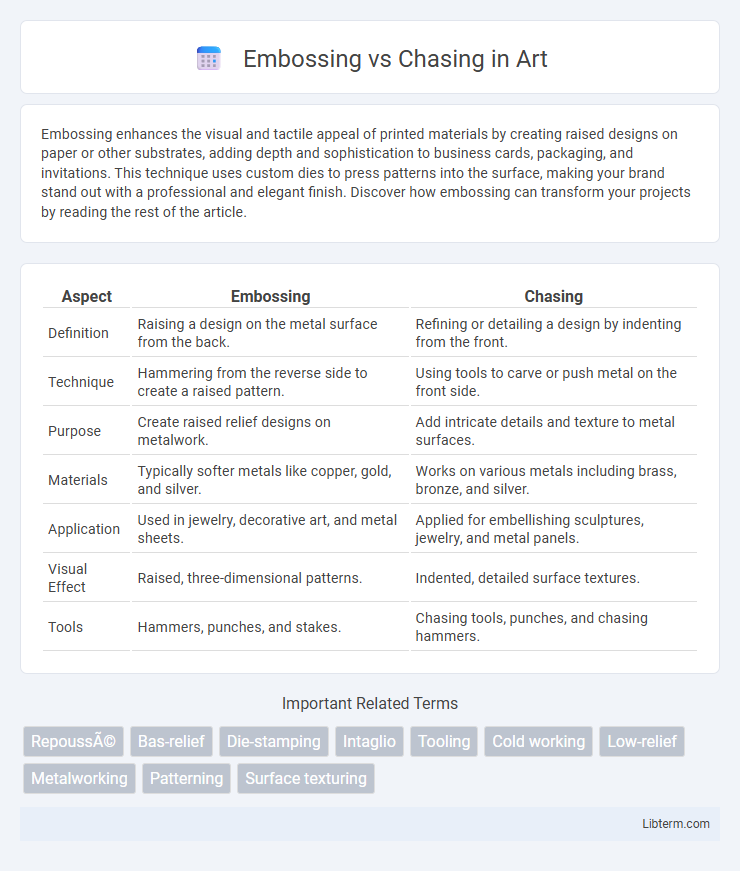Embossing enhances the visual and tactile appeal of printed materials by creating raised designs on paper or other substrates, adding depth and sophistication to business cards, packaging, and invitations. This technique uses custom dies to press patterns into the surface, making your brand stand out with a professional and elegant finish. Discover how embossing can transform your projects by reading the rest of the article.
Table of Comparison
| Aspect | Embossing | Chasing |
|---|---|---|
| Definition | Raising a design on the metal surface from the back. | Refining or detailing a design by indenting from the front. |
| Technique | Hammering from the reverse side to create a raised pattern. | Using tools to carve or push metal on the front side. |
| Purpose | Create raised relief designs on metalwork. | Add intricate details and texture to metal surfaces. |
| Materials | Typically softer metals like copper, gold, and silver. | Works on various metals including brass, bronze, and silver. |
| Application | Used in jewelry, decorative art, and metal sheets. | Applied for embellishing sculptures, jewelry, and metal panels. |
| Visual Effect | Raised, three-dimensional patterns. | Indented, detailed surface textures. |
| Tools | Hammers, punches, and stakes. | Chasing tools, punches, and chasing hammers. |
Introduction to Embossing and Chasing
Embossing creates raised designs on materials by pressing from the reverse side, producing a three-dimensional effect that enhances texture and visual appeal. Chasing refines the front surface by hammering detailed patterns into the material, adding intricate lines and depth without altering the back. Both techniques are essential in metalworking and crafts for decorative purposes, each offering unique aesthetic qualities and structural impacts.
Understanding the Basics: Definitions
Embossing is a metalworking technique that involves creating raised designs on a surface by pressing or hammering from the reverse side, producing a three-dimensional effect. Chasing refers to the process of refining or detailing the front side by sinking the metal to create intricate patterns and texture without piercing the surface. Both techniques are often combined in decorative metalwork to enhance depth and artistry.
Historical Background and Origins
Embossing and chasing are ancient metalworking techniques with origins dating back to ancient Egypt and Mesopotamia, used to create raised and recessed designs on metal surfaces. Embossing involves hammering metal from the reverse side to produce a raised pattern, while chasing refines the front side by indenting and detailing the design. These methods were essential in early art and craftsmanship, evolving through cultures and influencing decorative metalwork across civilizations.
Key Differences Between Embossing and Chasing
Embossing creates raised designs on a surface by pressing or stamping from the back, enhancing texture and depth, whereas chasing involves refining and detailing the front side by hammering without raising the metal. Embossing typically results in three-dimensional relief patterns, while chasing focuses on intricate surface detailing and contour definition. The key difference lies in the technique and effect: embossing adds volume and elevation, and chasing shapes and embellishes the metal's front face.
Tools and Materials Required
Embossing requires specialized tools like embossing styluses, embossing folders, and soft surfaces such as rubber mats or foam pads to create raised designs on metal, leather, or paper. Chasing involves metalworking tools including chasing hammers, chasing punches, and anvils to define or refine intricate patterns and textures on sheet metal. Both techniques necessitate high-quality metals like copper, silver, or brass, with embossing favoring thinner sheets and chasing suited for slightly thicker metals.
Techniques and Methods Used
Embossing involves creating raised designs on metal surfaces by hammering from the reverse side, utilizing tools like punches and styluses to achieve dimensional patterns. Chasing, conversely, works from the front side, employing hammers and chasing tools to refine and define the metal surface without raising it. Both techniques require precise control of pressure and angles to manipulate the metal's texture and form, often combined to produce intricate decorative effects.
Applications in Art and Industry
Embossing creates raised designs on metal or paper surfaces, widely used in packaging, book covers, and decorative arts to add texture and visual appeal. Chasing involves indenting or engraving metal to form intricate patterns, commonly applied in jewelry making, metalwork, and sculpture for detailed embellishments. Both techniques enhance artistic expression and functional design by manipulating surface relief in various industrial and artistic contexts.
Advantages and Disadvantages
Embossing creates raised designs on metal surfaces, enhancing texture and visual appeal with durability and depth, but it can be limited by the metal thickness and requires precise tooling. Chasing involves indenting or engraving the metal to create intricate patterns, offering detailed artistry and flexibility, yet it may weaken the metal and is often more labor-intensive. Both techniques complement each other in metalworking, with embossing excelling in bold relief effects and chasing in fine, delicate details.
Choosing the Right Technique for Your Project
Selecting between embossing and chasing depends on the desired texture and depth in your project; embossing raises the design above the surface, creating a three-dimensional effect, while chasing indents the metal, adding intricate details and depth. Consider the material type and thickness, as embossing works best on softer metals like copper, whereas chasing is suitable for harder metals such as silver and gold. Prioritize the visual impact and durability needed, since embossing often offers a bold, raised pattern, and chasing delivers fine, precise embellishments ideal for detailed work.
Conclusion: Embossing vs Chasing – Which to Choose?
Embossing creates raised designs by pressing metal from the back, ideal for adding texture and depth to surfaces, while chasing refines and defines details on the front, perfect for intricate patterns. Choose embossing when seeking bold, three-dimensional effects and chasing for precise, decorative highlights. Selecting between embossing and chasing depends on the desired visual impact and the specific metalworking technique suited to the project's artistic goals.
Embossing Infographic

 libterm.com
libterm.com